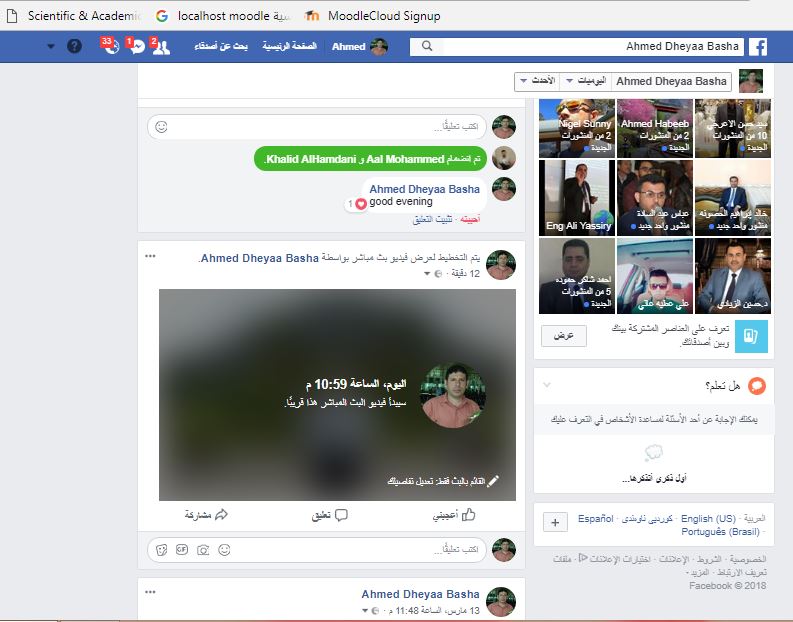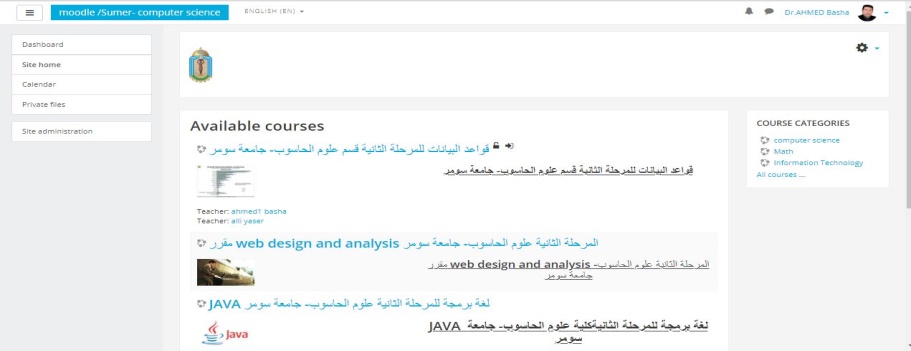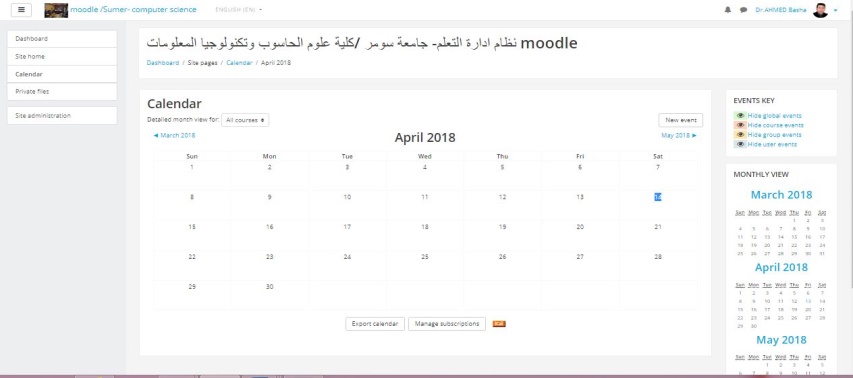-
Paper Information
- Paper Submission
-
Journal Information
- About This Journal
- Editorial Board
- Current Issue
- Archive
- Author Guidelines
- Contact Us
Journal of Wireless Networking and Communications
p-ISSN: 2167-7328 e-ISSN: 2167-7336
2018; 8(1): 7-11
doi:10.5923/j.jwnc.20180801.02

Applying Moodle Cloud Services in Iraqi Universities: Mobile Applications Course
Ahmed Dheyaa Basha
Computer Science & Information Technology, University of Sumer, ALQul,aa, Iraq
Correspondence to: Ahmed Dheyaa Basha, Computer Science & Information Technology, University of Sumer, ALQul,aa, Iraq.
| Email: |  |
Copyright © 2018 The Author(s). Published by Scientific & Academic Publishing.
This work is licensed under the Creative Commons Attribution International License (CC BY).
http://creativecommons.org/licenses/by/4.0/

Interactive applications for Moodle cloud in education sector became one of the directions of information technology development in 2016-2018 especially with portable devices (mobile devices). Iraqi universities struggled to apply Moodle cloud services via mobile applications to advance productivity with professors and students, to improve overall quality of higher education. In this paper live (API) tools of social media in Facebook used as a port through Moodle cloud services, Google disk and set of mobile applications’ features are used to facilitating all academic activities in course by Moodle cloud. The paper included proposed framework of Moodle cloud as a one of educational content management systems with the help of mobile applications that building in frames of course in University of Sumer as a one of Iraqi universities.
Keywords: Moodle cloud, Mobile application course, Social media, live (API), LMS
Cite this paper: Ahmed Dheyaa Basha, Applying Moodle Cloud Services in Iraqi Universities: Mobile Applications Course, Journal of Wireless Networking and Communications, Vol. 8 No. 1, 2018, pp. 7-11. doi: 10.5923/j.jwnc.20180801.02.
Article Outline
1. Introduction
- Interactive applications for Moodle cloud in education sector became one of the directions of information technology development especially with portable devices (mobile devices).One of important the features of mobile application in learning are courses with the Moodle cloud services as an application of interactive methods with all the classes synchronous and non-synchronous [9-7]. All higher education universities involved high attention to the development and improve of interactive methods and teaching environment like Moodle cloud environment with suitable devices to learn persons [5-1]. Newly, the rising of Moodle cloud, as a gate to online knowledge-sharing community in universities, formed by interpersonal interaction anytime and anywhere [11-8]. Moodle cloud known as a free and open-source, it serves and meet different needs in public or private websites via use different portable devices (such as mobile devices) and numerous applications in situations officially or non-officially with availability of the Internet [15-13]. For instance, academic sites (to upload documents, assignment, registration, notifications and navigation) and social media sites (like Facebook) for multi-purpose (video live (API) used as a video conference, chatting and Correspondence) [4-6-10]. Moreover, and according to many reports from “Mobile World Congress” 2016, 2017 [7] focused on the directions toward mobile devices as a high demand in scope of mobile learning in universities. Urgent demand for mobile learning is increasing, currently, new technologies still alone and not improves the experience of mobile learners in higher education. Learning content in universities must be adapted to achieve personal needs of those learners within their modern current context [10-3]. However, this study struggled to apply Moodle cloud services through mobile devices to present high quality of educational content in Iraqi higher education, especially with live (API) tools of social media in Facebook that used as a package available in Moodle cloud services.
2. Active Moodle Cloud in System of Mobile Learning Management
- Moodle cloud services via system of mobile learning management are one of major instruments of mobile learning [14]. Traditional ways to the work with learning management system (LMS) involves different tasks like data storage need to execution chain of actions which creates many difficulties especially with learning content editing [13]. For instance, download the different document of the server; save it on the computer devices; edit it neatly; upload document to the LMS server; delete and add the link to the new version of the document: student file editing by professor requires complicated process and extra actions in term of delete and upload new version [1-8]. Subsequently, these redundant actions cause professors’ time losses and students. Thus, creation active Moodle cloud in system of mobile learning management to the learning content reduces time and efforts and leads to integration services cloud of learning contents through Moodle cloud and available facilitates publishing and learning management especially courses content for student to develop; save of the documents; upload different software; replay comments and watching video for professor synchronous and non-synchronous for example by live (API) in Facebook across social media which already linked with Moodle cloud site to be used through mobile devices and its applications to serve learning contents [4-9-12].
3. Moodle Cloud Services and Technology’s Applications
- New Learning Management system (LMS) include system of mobile learning management is high-level to conduction and manage of the studying course in universities [7]. In this respect, contents published comply with a standard of Moodle cloud in terms of interactivity; visual elements like graphics; animation, video etc. in addition the, the openness number of subscribers to content in Moodle cloud it belongs to community that open exchange of opinions regarding the course and create control to process educational contents [10-2]. For the time being, there exist some options of (LMS) acquisition by the institutions included:1. LMS are developed and improved by the institutions themselves;2. LMS is used as a platform via Commercial sector to publish on the server of the institution;3. LMS is spread by sharing software as a service on cloud services.However, development Learning Management System (LMS) by institution is very difficult and need long-term of initialization and process [3]. For instance, many (LMS)-platforms used server of the institution via popular open source software. These (LMS)-platforms applicable, analysis, develops and editing include:1. LMS-platforms eFront (www.).2. LMS –platform Moodle.3. LMS-platform Black board Learn.In this respect, many LMS starting by numbers of developers regarding cloud and became popular in the world based on learning management through different software for instance:1. Docebo (www.docebo.com).2. Litmos (www.litmos.com).3. Torch (torchlms.com).Consequently, the author chose LMS Moodle cloud as a platform for University of Sumer. This choice was chosen for multi reasons: easy and friendly interface, diversity of management elements, popular LMS-platforms in term of connectivity with social media like Facebook, and open source product etc., [9-11]. Moreover, Moodle cloud subscription free for students and teachers. In addition, support cloud services for mobile learning that use multi- applications developed by Google disk, Microsoft, YouTube etc. These features that provide different variety of possibilities to work with learning content including interactive access, online course, preview and editing and different services that organization or university access to them. To create documents or folder via course, the professor provide students password and email to login through Moodle cloud web site (https://sumer.moodlecloud.com/) with opportunity of collaborative and chatting or send assignment anytime and anywhere or discussion directly through live (API) in Facebook across set of social media that connectivity with Moodle cloud and Internet availability. In addition, using various applications package like Microsoft office and video that download from or to Moodle cloud by portable devices to be use and available for students and professor during the educational course freely. As a result, of LMS Moodle cloud services it was possible to solve several following tasks:1- Creation educational groups of students and professors;2- University ease establishes the calendar with academic tasks and possibility of automatic notification to students or themselves about the tasks and its completion;3- Discussion of specific applications via lectures with follow much software through the course;4- Collaborative and editing documents between members of the groups and professors;5- Display multi learning materials to publishing via course with potential and opportunity for update or delete and explore;6- Exchange the tasks and reports in case of the absence some student for a reasonable excuse, easy of services accessible anytime and anywhere by mobile devices;7- Control and monitoring several educational tasks of course completion during the semester.
 | Figure 1. Framework present interactive persons with social media through Moodle cloud |
 | Figure 2. Shows Facebook as a social media used in course through Moodle cloud |
 | Figure 3. Shows video live API in course via Moodle cloud as video conference |
 | Figure 4. Shows video live (API) during the course via Moodle cloud by using portable devices (mobile) |
 | Figure 5. Shows login teacher with web site of university |
 | Figure 6. Shows list of course for students |
 | Figure 7. Shows course categories |
 | Figure 8. Shows activities with Calendar |
 | Figure 9. Shows activity with resource available with Moodle cloud services |
4. Conclusions
- The paper describes framework and a new way in educational content included Moodle cloud services and how link with social media (Facebook) to form educational content in Iraqi universities (university of Sumer). LMS –platform Moodle cloud used to edited and store learning content. Consist of different environments to publish content. Moreover, the content becomes active and changes in information resources that shown automatically and easily in the LMS include Moodle cloud as a virtual environment synchronous and non-synchronous. Thus, more importantly and biggest part are activities related to professors and their students that conducted in mobile applications with the outcomes of these activities very easy to the course students on active links in LMS platform via Moodle cloud.
ACKNOWLEDGEMENTS
- I would think University of Sumer to support my work especially faculty of Computer of Sciences & Information Technology and their staff.
 Abstract
Abstract Reference
Reference Full-Text PDF
Full-Text PDF Full-text HTML
Full-text HTML